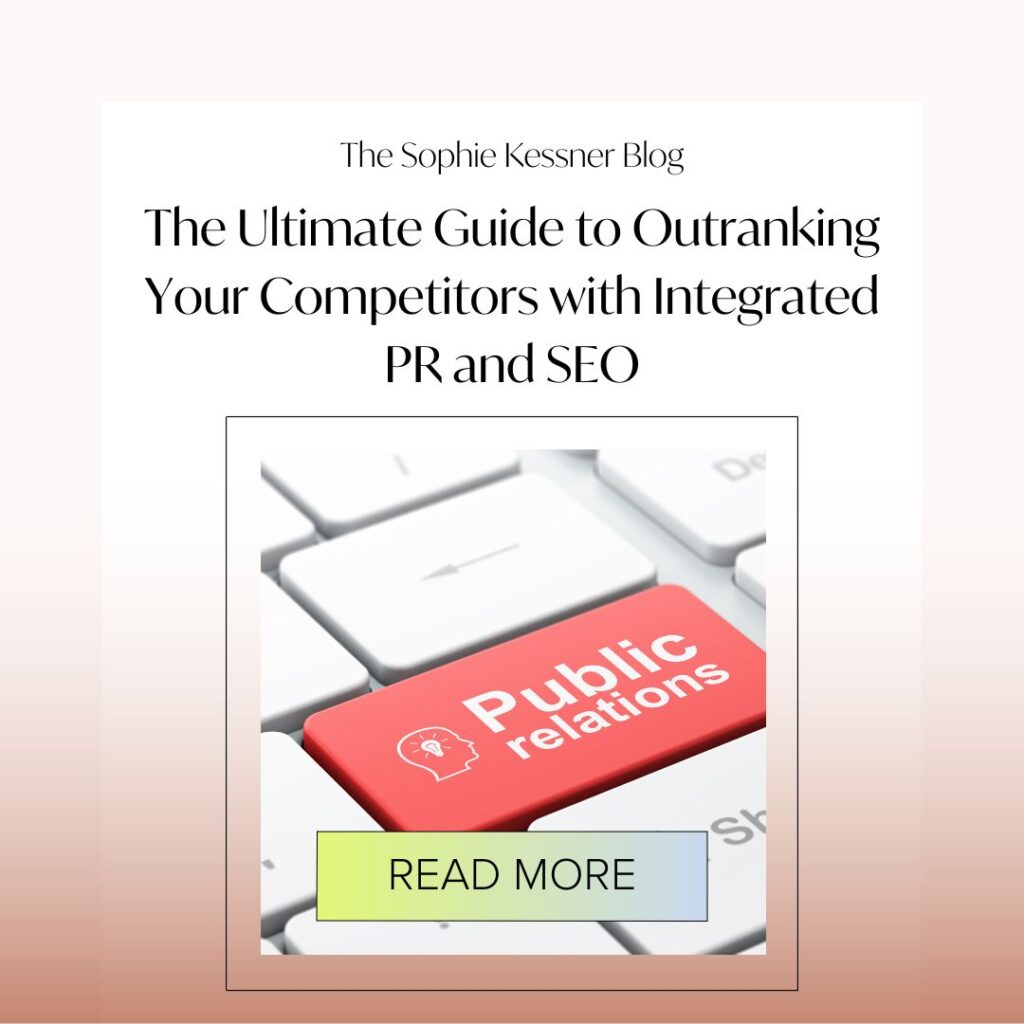Public Relations (PR) and Search Engine Optimization (SEO) are two sides of the same coin. PR builds credibility and brand awareness, while SEO ensures your content stays visible and drives long-term traffic. When combined as part of a broader digital marketing strategy, they create a powerful approach that helps brands outrank competitors, earn high-quality backlinks, and attract the right audience.
Many businesses treat PR and SEO as separate efforts, missing out on the full potential of integration. PR placements can boost search rankings, and SEO insights can guide PR strategies for maximum impact. This shift is becoming more evident—global searches for “digital PR” have increased by 34% since 2020, showing a rising awareness of its role in brand visibility and SEO. By aligning these two disciplines, brands can gain authority, improve organic reach, and maintain a consistent presence across all digital channels.
This guide breaks down how to integrate PR and SEO step by step. You’ll learn the key benefits, proven strategies, and real-world examples to help you leverage both for long-term success.
Understanding the Fundamentals
Digital PR is all about building a brand’s reputation online. It focuses on increasing visibility, earning trust, and engaging with the right audience. Unlike traditional PR, which relies on print and broadcast media, digital PR leverages online platforms like news sites, blogs, and social media to spread brand messaging.
The main objectives of digital PR include boosting brand awareness, managing reputation, and fostering audience engagement. Core tactics involve securing media coverage, collaborating with influencers, and distributing valuable content across high-authority sites. A strong PR strategy helps businesses gain credibility and recognition in their industry.
SEO Essentials for PR Professionals
SEO (Search Engine Optimisation) ensures that a brand’s content is easily found online. It revolves around optimizing websites, creating valuable content, and earning backlinks to improve search rankings. SEO is built on three core pillars:
Technical SEO: Ensuring website structure, speed, and mobile-friendliness are optimized for search engines.
On-Page SEO: Crafting keyword-optimized content, meta tags, and headers to boost relevance.
Off-Page SEO: Earning backlinks from authoritative sites to increase domain authority.
Optimizing for other search engines is also important, as high-quality backlinks influence rankings across all search platforms, enhancing overall SEO performance.
For PR professionals, understanding SEO is crucial. When PR content is optimized for search, it drives sustained traffic, enhances credibility, and improves overall online presence.
The Overlapping Goals of PR and SEO
PR and SEO share a common objective—visibility. PR helps brands earn media placements, while SEO ensures those placements drive long-term value. High-authority backlinks from PR coverage strengthen a website’s search rankings, making it easier for potential customers to find a brand.
When PR and SEO work together, brands don’t just gain short-term media exposure; they also build a strong digital foundation that continues to attract organic traffic.
The Benefits of a Unified PR and SEO Strategy

A well-integrated strategy helps brands go beyond short-term media buzz. Instead of relying solely on news cycles, businesses can build long-lasting authority, increase organic reach, and strengthen customer trust. Here’s why combining PR and SEO is a game-changer:
Broader Audience Reach: PR places a brand in front of journalists, bloggers, and influencers, while SEO ensures that content ranks on search engines. Together, they expand visibility across multiple platforms, attracting a wider audience.
Higher Brand Authority and Trust: When a business is featured in reputable media outlets, it builds credibility. SEO reinforces this by ensuring those mentions appear in search results, making the brand more trustworthy in the eyes of potential customers.
Natural, High-Quality Backlinks: One of SEO’s biggest ranking factors is backlinks from authoritative websites. PR efforts, such as press releases and media features, naturally generate these valuable links, improving a website’s domain authority and search rankings.
Increased Website Traffic and Conversions: PR stories can drive immediate referral traffic, while SEO ensures a steady flow of organic visitors over time. This dual approach helps businesses attract and convert high-intent users.
Stronger Influencer Relationships: Digital PR fosters relationships with journalists, bloggers, and influencers who can amplify brand messaging. These collaborations often lead to guest posts, interviews, and partnerships that enhance both PR and SEO efforts.
More Effective Content Performance: SEO research helps PR teams create content that aligns with search trends. A well-designed web page that prioritizes user experience (UX) can significantly enhance SEO performance by reducing bounce rates and increasing user engagement. By integrating keywords and search intent into PR assets, brands can maximize content reach and engagement.
Consistent Messaging Across All Channels: A unified strategy ensures that PR and SEO teams work toward the same goals, maintaining consistent messaging across search engines, media coverage, and social platforms.
By aligning PR and SEO, brands can strengthen their online presence, attract quality traffic, and stay ahead of competitors in both media and search rankings.
The Step-by-Step Guide to PR and SEO Integration
Bringing PR and SEO together requires a structured approach. Instead of treating them as separate marketing efforts, businesses should align their goals, collaborate effectively, and use SEO-driven tactics to enhance PR campaigns. Follow these steps to create a seamless strategy that improves rankings, builds brand authority, and drives long-term growth.
Step 1: Align Goals and KPIs
PR and SEO teams often work with different priorities—PR focuses on brand exposure and media relationships, while SEO aims to improve search visibility and traffic. The key to integration is finding common ground and defining shared KPIs that measure success for both.
Some key metrics to track include:
Number of media placements with backlinks – Links from authoritative sites strengthen domain authority and search rankings.
Organic traffic growth – PR-driven content should bring in qualified visitors from search engines.
Brand mentions and referral traffic – Media coverage should generate direct visits and increase brand awareness.
Keyword rankings – Content created for PR campaigns should align with SEO goals, ensuring it ranks for relevant search queries.
SEO has become a priority for marketers, with 88% of businesses planning to maintain or increase their SEO investment in 2023. By setting measurable goals that benefit both PR and SEO, teams can ensure their efforts contribute to overall business success.
Step 2: Foster Collaboration Between PR and SEO Teams
Silos between PR and SEO departments can slow down progress. Instead of operating separately, businesses should establish clear workflows that encourage collaboration.
Ways to improve communication include:
Regular strategy meetings – Align PR campaigns with SEO-driven content to maximize impact.
Shared editorial calendars – Ensure media outreach efforts and keyword-focused content creation work hand in hand.
SEO training for PR teams – Teach PR professionals how search rankings work and the importance of securing backlinks.
PR education for SEO teams – Help SEO specialists understand media relations and storytelling techniques.
A well-connected PR and SEO team ensures that every piece of content, press release, or media mention serves both branding and search visibility goals.
Step 3: Plan Keyword-optimized PR Content
To make PR efforts SEO-friendly, content should be created with search intent in mind. This means incorporating relevant keywords into PR-driven content while maintaining a natural, engaging tone.
How to find the right keywords:
Use Google Trends and Ahrefs to identify trending topics that journalists and search audiences care about.
Research high-intent keywords that align with your expertise and media opportunities.
optimize press releases, guest articles, and interviews with natural keyword usage.
For example, if a mental health therapist is launching a media campaign on anxiety treatment, they should optimize content for keywords like “how to manage anxiety” or “best therapy for anxiety” while ensuring the message remains media-friendly.
Step 4: optimize PR for SEO
Many PR strategies focus solely on media coverage without considering how they impact search rankings. However, integrating SEO PR efforts can significantly enhance SEO performance by creating backlinks and managing brand reputation.
To optimize PR for SEO:
Use SEO-friendly press releases – Include relevant keywords naturally in the title and body.
Request backlinks in media mentions – When journalists quote you, ask if they can include a link to your website.
Optimize newsroom pages – If your website has a media page, ensure it’s structured for SEO, making it easy for journalists and search engines to find company news.
The goal is to make PR content work beyond short-term visibility—by optimizing for SEO, media coverage can contribute to long-term search traffic.
Step 5: Use PR for Link Building
High-quality backlinks are one of the most valuable SEO benefits of PR. Instead of relying on traditional link-building tactics, businesses should focus on earning media mentions from authoritative sources.
Best practices for PR-driven link building:
Target high-authority sites – Get featured in reputable news outlets, industry blogs, and digital magazines.
Leverage expert commentary – Provide valuable insights that journalists want to quote in their articles.
Use PR platforms wisely – HARO (Help a Reporter Out) has been discontinued, but alternatives like Qwoted and Featured can still help businesses connect with journalists.
Avoid outdated guest blogging tactics – Many sites have tightened editorial guidelines, making strategic partnerships and earned media placements more effective.
The impact of PR-driven link building is undeniable. Brands that earn high-authority backlinks through digital PR see significant improvements in search rankings, proving that PR isn’t just about brand exposure—it directly influences SEO performance. By securing natural backlinks through PR efforts, businesses can improve domain authority, strengthen SEO rankings, and attract referral traffic.
Step 6: Amplify PR with SEO
Once PR campaigns generate media coverage, SEO tactics can extend their impact. Instead of letting a press mention fade, businesses should integrate it into their overall content strategy.
Ways to amplify PR efforts using SEO:
Internally link media mentions – If your business is featured in a top publication, use internal links to connect that article to relevant blog posts or landing pages, reinforcing site structure and boosting SEO.
optimize pages tied to PR campaigns – Ensure web pages related to your media coverage are optimized for search visibility.
Repurpose PR content across digital channels – Turn media interviews, research findings, or featured articles into blog posts, LinkedIn updates, and email campaigns.
By combining PR exposure with SEO best practices, businesses can maximize the reach and longevity of their media wins.
Step 7: Track and Measure Results
To prove the value of integrating PR and SEO, businesses need to track key performance metrics. This data-driven approach ensures ongoing improvements and helps justify continued investment.
Key metrics to monitor:
Number of backlinks and their quality – High-authority links boost domain authority and search rankings.
Organic search traffic from PR-related content – Measure how media mentions drive visitors to your site.
Keyword rankings for PR-driven content – Track how well press releases, interviews, or industry reports perform in search results.
Referral traffic from media placements – See how many website visitors come directly from press features.
Using tools like Google Analytics, Ahrefs, and SEMrush, businesses can measure the long-term impact of PR and SEO integration.
Advanced Strategies for Outranking Competitors

Once the basics of PR and SEO integration are in place, it’s time to refine your strategy. Competitors are also working to improve their online visibility, so staying ahead means using smarter, data-driven tactics.
Analyze Competitor PR and SEO Efforts
Look at what top competitors are doing. Use tools like Ahrefs or SEMrush to analyze their backlinks, media placements, and keyword rankings. Identify gaps in their strategy and target opportunities they’ve missed, such as niche publications or underutilized keywords.
Use Data to Refine Outreach and Content
SEO provides valuable insights into what your audience searches for, while PR ensures the content reaches the right people. Use search data to create more relevant press releases, blog posts, and media pitches. Prioritize high-intent keywords and trending industry topics to increase engagement.
Leverage Multimedia for Better Engagement
Text-only content is no longer enough. Incorporate videos, infographics, and interactive elements into PR campaigns. Google favors multimedia-rich content, and journalists are more likely to feature brands that provide high-quality visuals.
Optimize for Local SEO
For businesses targeting specific regions, local SEO is a must. Secure mentions in local news outlets, optimize Google Business Profile listings, and encourage reviews on high-authority local directories. Location-based PR efforts can drive significant organic traffic.
Explore AI Tools for Content and Outreach
AI-powered tools like ChatGPT, BuzzSumo, and Clearscope can streamline PR and SEO tasks. Use them to generate content ideas, optimize press releases, and personalize media outreach. Automation can also help track mentions, backlinks, and industry trends more efficiently.
By applying these advanced strategies, brands can outperform competitors in search rankings, media coverage, and audience engagement—ensuring long-term digital success.
Common Challenges and How to Overcome Them

Integrating PR and SEO isn’t always straightforward. Many businesses struggle with team alignment, measuring success, and securing stakeholder buy-in. Here’s how to tackle these challenges effectively.
Breaking Down Silos Between Teams
PR and SEO often operate separately, leading to missed opportunities. The key is fostering collaboration through:
Regular strategy meetings to align content, outreach, and goals.
Shared content calendars that incorporate SEO-driven PR efforts.
Cross-training teams so PR professionals understand SEO basics and vice versa.
When both teams work together, media coverage becomes more than just a temporary boost—it strengthens long-term search visibility.
Measuring the ROI of Integrated Efforts
PR success is often measured in media placements, while SEO focuses on rankings and traffic. To track the full impact, businesses should:
Monitor backlinks from PR campaigns and their effect on domain authority.
Track organic traffic and conversions from media mentions.
Use Google Analytics and Ahrefs to measure referral traffic and keyword improvements.
By combining PR and SEO metrics, brands get a clearer picture of how their efforts drive business growth.
Getting Buy-In from Stakeholders
Many decision-makers see them as separate functions. To secure investment in an integrated strategy:
Showcase case studies that demonstrate success.
Present data on SEO benefits from PR efforts (e.g., improved rankings, increased traffic).
Emphasize the long-term value of high-quality backlinks and media exposure.
Educating stakeholders on the synergy between PR and SEO makes it easier to secure resources and support for a unified approach.
By overcoming these challenges, businesses can fully leverage PR and SEO to build authority, rank higher, and drive sustainable growth.
The Future of PR and SEO: What’s Next?

As search engines and digital media evolve, PR and SEO integration will become even more essential. Here’s what businesses should expect in the coming years.
The Growing Importance of PR in SEO Rankings
Google is placing more emphasis on authority and credibility, meaning high-quality backlinks and brand mentions will play an even bigger role in search rankings. Digital PR will no longer be just about publicity—it will be a core part of SEO success.
AI and Automation in PR and SEO
AI-powered tools are already transforming content creation, media outreach, and keyword research. Businesses that leverage AI-driven insights will gain a competitive edge by:
Identifying trending topics faster.
Automating outreach to journalists and influencers.
optimizing content more efficiently for both search engines and human readers.
The Shift Toward Multimedia Content
Search engines are prioritizing rich media formats like videos, podcasts, and interactive content. Future PR and SEO strategies will need to include video interviews, expert panels, and dynamic visuals to boost engagement and rankings.
Evolving Search Algorithms and Brand Visibility
Google’s algorithms are constantly changing, but one thing remains clear: brands with strong online reputations will win. A well-integrated strategy ensures that businesses remain visible, authoritative, and competitive—no matter how search evolves.
Staying ahead means embracing these media trends early and continuing to refine PR and SEO efforts for long-term success.
Conclusion: Take Action for Long-Term Success
PR and SEO are no longer separate strategies—they work best when combined. PR builds trust and authority, while SEO ensures sustained visibility. Together, they create a powerful framework for brand growth.
By aligning goals, optimizing content for search, and using PR for link building, businesses can outperform competitors and build lasting online credibility. The key is consistency—integrating PR and SEO isn’t a one-time effort but an ongoing strategy that adapts to industry trends and search algorithm changes.
Now’s the time to put these strategies into action. Start small, track results, and refine your approach. At SassandSEO, we help businesses implement smart, sustainable SEO strategies through expert-led courses and agency services—so you can see real results in rankings, traffic, and brand authority.
FAQs on PR and SEO Integration
1. Why should PR and SEO be integrated?
PR builds brand trust, while SEO ensures long-term visibility. When combined, they help businesses rank higher in search results, earn quality backlinks, and attract the right audience.
2. How do backlinks from PR improve SEO?
When high-authority websites mention your brand and link to your site, search engines see it as a trust signal. These backlinks boost domain authority, improve rankings, and drive referral traffic.
3. Can PR help with keyword rankings?
Yes! PR efforts that secure media coverage on authoritative sites often include relevant keywords, reinforcing your site’s topical relevance and improving search rankings over time.
4. What are some easy ways to start integrating Public Relations and SEO?
Start by optimizing press releases with keywords, securing backlinks in media mentions, and collaborating between teams to align content strategies.
5. How do you measure the success of Public Relations and SEO integration?
Track metrics like organic traffic, backlink quality, keyword rankings, and referral traffic from media mentions. Over time, you should see stronger search visibility and brand authority.





